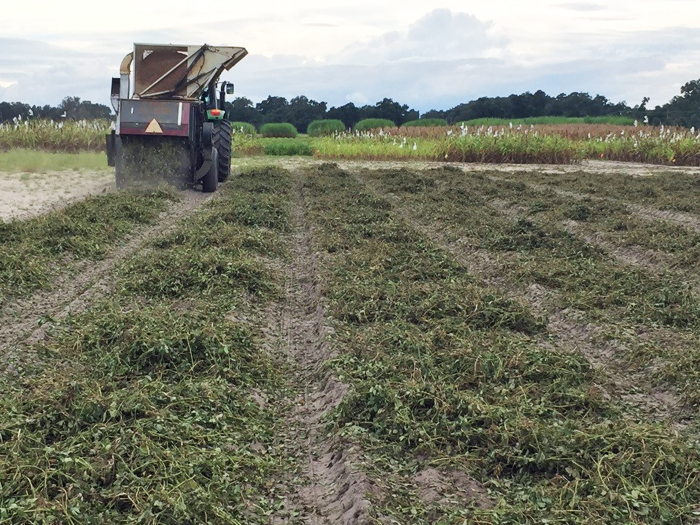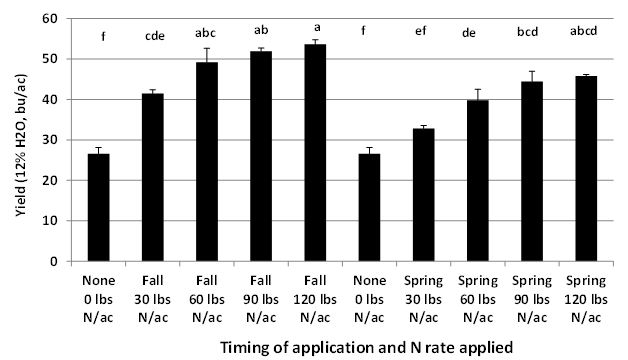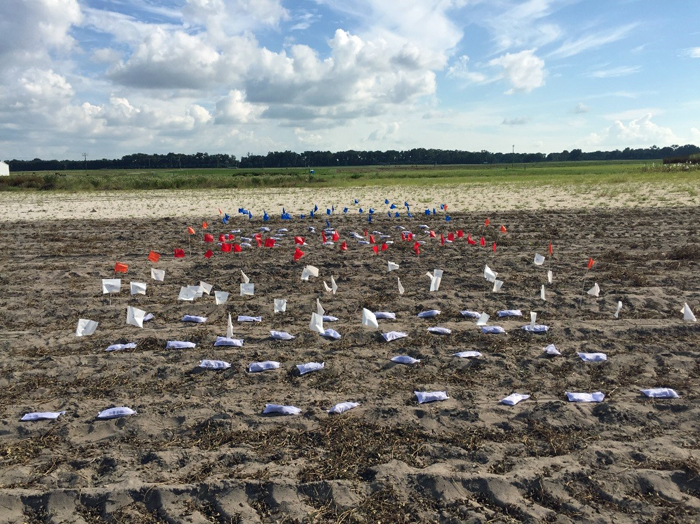
Figure 2- Peanut harvest at Citra yielded 6,192 lbs/ac peanuts with 6.3 tons/acre (dried) of leftover residue.
Dr. Michael J. Mulvaney, Cropping Systems Specialist – University of Florida, West Florida Research and Education Center
Raymond J. Geisel, Graduate Student – University of Florida, Soil and Water Science Department
You’ve got your peanut crop out of the ground. Your harvest was good. With all this talk of an El Niño year, you want to plant a cover crop to protect your soil. Should you give that cover crop that will follow peanuts a nitrogen (N) credit (lower than normal N fertilization) since your peanut harvest was so good?
Short answer: No!
Although there are several extension publications that recommend a N credit after peanut, the scientific peer-reviewed literature does not support those recommendations. Oklahoma Extension estimates a 20-60 lbs N/ac credit to subsequent crops after peanut (1), while UGA Extension recommends a 20 lbs N/ac credit to canola after peanut (2). For a subsequent cotton crop, Alabama Extension recommends a 20-30 lb N/ac credit after peanut (3) and Virginia Extension recommends a 45 lb N/ac credit after peanut (4, 5).
I dug into the scientific literature to find out how those recommendations were determined. Below is a summary of what I found. Judging from the scientific literature, it would be difficult to recommend a N credit after peanut. So how did the Extension recommendations of 20-60 lbs N/ac come about? I believe these recommendations were ‘grandfathered’ in from bygone eras, and remain part of Extension recommendations to this day.
Judging from the scientific literature, it would be difficult to recommend a N credit after peanut. So how did the Extension recommendations of 20-60 lbs N/ac come about? I believe these recommendations were ‘grandfathered’ in from bygone eras, and remain part of Extension recommendations to this day.
Granted, it is difficult and expensive to quantify the exact amount of N that should be credited to subsequent crops after peanut. And I’m not saying there isn’t some N benefit – but I am saying that it is not documented in the scientific literature. And without science-based data, we can’t make science-based recommendations. So I recommend no N credit following peanut until such time that we can prove otherwise.
Just because there is no N credit after peanut does not mean there aren’t benefits to leaving the residue on the soil surface. Crop residues protect the soil from erosion, increase organic matter content, and increase infiltration, among other benefits.
Now that you’re going to apply N to your winter crop after peanut, how much should you apply and when? UF/IFAS recommends a single shot of N in late January or early February. Ordinarily, N application before stem elongation makes sense, particularly on sandy, well-drained soils common in the Southeast. But I was curious if that would be true on our heavier soils here in the western Panhandle, so last year I conducted a single-shot N test to wheat after peanut. Those results are shown in Figure 1.

Figure 1. Single shot N application timing and rates for wheat production after peanut in Jay, FL during 2014-15. Broadcast urea applications were made immediately after planting in the Fall or in the Spring in mid-February.
Surprisingly, the highest wheat yields were achieved using a Fall application for any given N rate. A single shot of 60 lbs N/ac yielded 49 bu/ac, compared to 40 bu/ac if the same rate was applied in February. Looked at another way, 30 lbs N/ac applied after planting yielded the same or a little higher than 60 lbs N/ac applied in February. More data are necessary to see if this trend will hold in subsequent years, but these preliminary data suggest that on our heavier soils in the western Panhandle, single shot N applications may be best applied in the Fall.
We recently began an experiment measuring the decomposition rates of peanut residue under differing residue loads. Figure 2 above illustrates the large amount of residue leftover from harvest. We began this experiment by adding residue to mesh bags at 1, 2, 3, and 4 tons/acre to illustrate differing residual loads. The bags we placed into the field and are taken up at specified times over the coarse of a year. The bags were placed on the surface, buried, and the rest will be buried in February. Figure 3 depicts what the experiment looked like when the residue bags were placed into the field.

Figure 3- Peanut Residue in decomposition bags to measure mineralization rates under differing tillage
We will be starting another experiment this fall to quantify nitrogen contributions from peanut to rye. We hope to gain a better understanding of N contributions to subsequent crops following peanut.
References:
- J. Caddel, D. Redfearn, H. Zhang, J. Edwards, S. Deng, “Forage legumes and nitrogen production,” Oklahoma Cooperative Extension Service No. Oklahoma State University Extension Facts, No. 2590 (Oklahoma State University Extension Facts, No. 2590, 2006).
- G. D. Buntin et al., Canola production in Georgia. (2007).
- C. C. Mitchell, S. Phillips, in Research-based soil testing and recommendations for cotton on Coastal Plain soils, C. C. Mitchell, Ed. (Alabama Agricultural Experiment Station, Auburn, AL, 2010), vol. 410, chap. 5, pp. 68.
- R. O. Maguire, S. E. Heckendorn, “Soil test recommendation for Virginia,” (Virginia Tech, Blacksburg, VA, 2011).
- VDCR, “Virginia Nutrient Management Standards and Criteria,” (Dept of Conservation and Recreation, Division of Soil and Water Conservation, Richmond, VA, 2014).
- K. S. Balkcom, C. W. Wood, J. F. Adams, B. Meso, Suitability of peanut residue as a nitrogen source for a rye cover crop. Sci. Agric. 64, 181-186 (2007).
- K. S. Balkcom, C. W. Wood, J. F. Adams, B. H. Wood, Composition and decomposition of peanut residues in Georgia. Peanut Science 31, 6-11 (2004).
- B. Meso, K. S. Balkcom, C. W. Wood, J. F. Adams, Nitrogen contribution of peanut residue to cotton in a conservation tillage system. J. Plant Nutr. 30, 1153-1165 (2007).
- M. J. Mulvaney, Auburn University, Auburn, Alabama (2010).
- S. J. Smith, A. N. Sharpley, Soil nitrogen mineralization in the presence of surface and incorporated crop residues. Agron. J. 82, 112-116 (1990).
- A. R. Anuar, Z. H. Shamsuddin, O. Yaacob, Contribution of legume-N by nodulated groundnut for growth of maize on an acid soil. Soil Biology & Biochemistry 27, 595-601 (1995).
- S. A. Ennin, H. K. Dapaah, R. C. Abaidoo, Nitrogen credits from cowpea, soybean, groundnut and mucuna to maize in rotation. West African Journal of Applied Ecology 6, 65-74 (2004).
- Four Early-Season Lessons from 2020 Peanut Production - April 9, 2021
- Sprayer Calibration Tables – Calibration Made Easy - October 30, 2020
- Stand Issues – Should You Replant Your Peanut Field? - May 15, 2020
